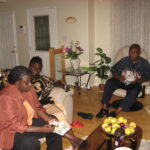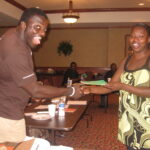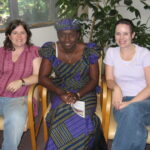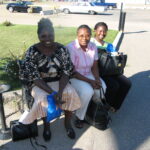A HISTORY OF TANGALE RULERS
A report on the history of the Tangale people submitted to the Tangale Traditional Council by a committee set up under Mr. Joshua Usman states that eleven “Mai Tangalem Kude ruled the Tangale people before the coming of the Europeans in 1904.”
Below is the genealogical tree chart of the Tangale Ruling Houses (Miyem Ma Mai) showing the chronology of ascension into power from the 13th century. The chart developed by Tangale historian Ankruma NHS is premised on the works of AB Mathews NAK/BAUPRO/31B” pagan Administration Tangale Waja District” page 7.
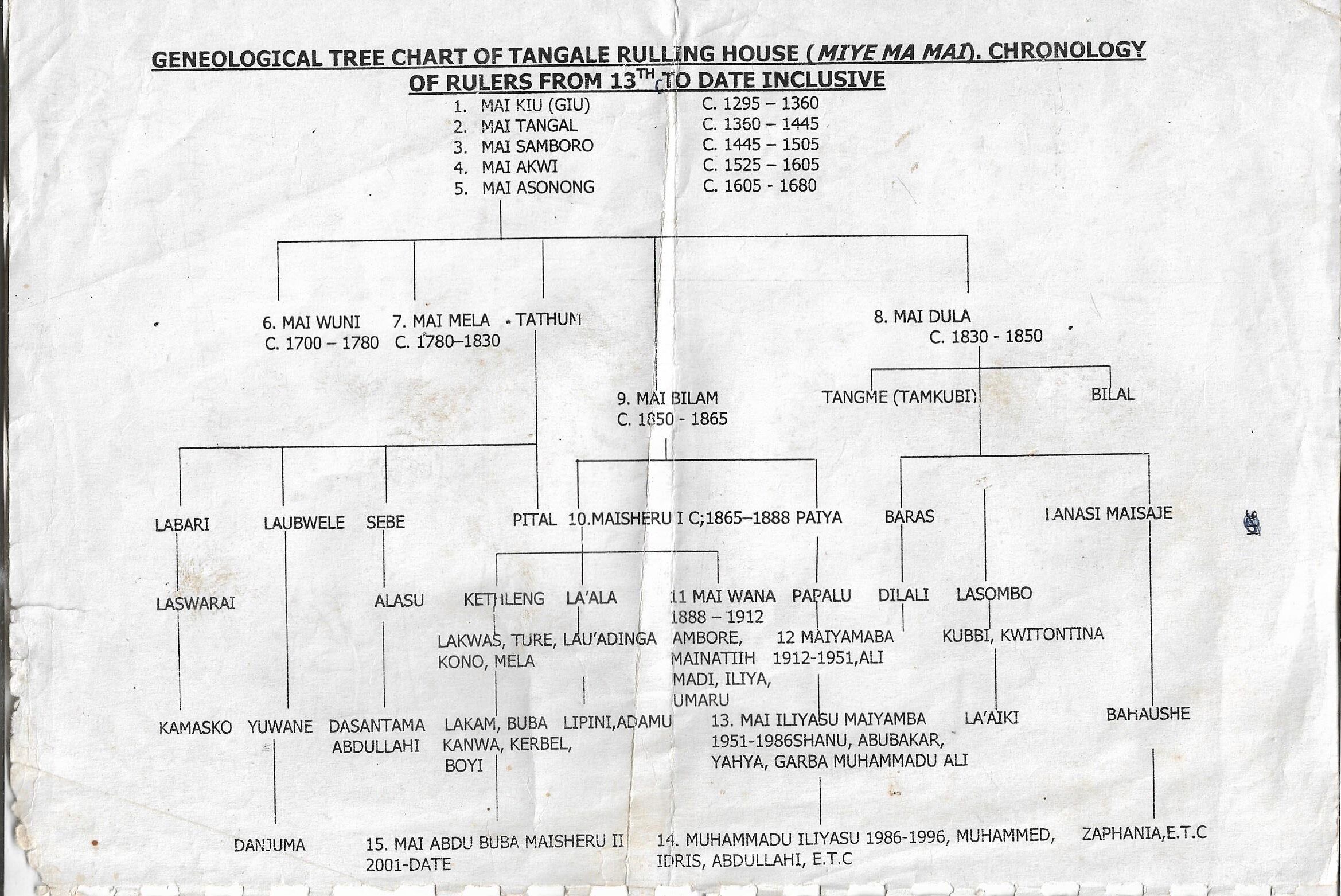
The genealogical tree above was used to develop the table below containing the list of 15 Mai’s that ruled Tangale land beginning with Mai Giu in 1295.
| SN | Name | Duration | Reign |
| 1 | Mai Kiu (Giu) | 1295 – 1360 | 65 Years |
| 2 | Mai Tangal | 1360 – 1445 | 85 Years |
| 3 | Mai Somboro | 1445 – 1505 | 60 Years |
| 4 | Mai Akwi | 1525 – 1605 | 80 Years |
| 5 | Mai Asonong | 1605 – 1680 | 75 Years |
| X | No Ruler | 1680 – 1700 | 20 Years |
| 6 | Mai Wuni | 1700 – 1780 | 80 Years |
| 7 | Mai Mela | 1780 – 1830 | 50 Years |
| 8 | Mai Dula | 1830 – 1850 | 20 Years |
| 9 | Mai Sheru I | 1850 – 1865 | 15 Years |
| 10 | Mai Bilam | 1865 – 1888 | 23 Years |
| 11 | Mai Wana | 1888 – 1912 | 24 Years |
| 12 | Mai Yamba Palpalu | 1912 – 1951 | 39 Years |
| 13 | Mai Iliyasu Maiyamba | 1951 – 1986 | 35 Years |
| 14 | Mai Muhammadu Iliyasu Maiyamba | 1986 – 1996 | 10 Years |
| X | No Ruler | 1996 – 2001 | 5 Years |
| 15 | Mai Abdu Buba Maisheru II | 2001 – 2021 | 20 Years |
| X | Vacant | 2021 – |
SUMMARIES ON THE TANGALE RULERS (MAI TANGLES)
The summaries on the first 10 past Tangale rulers (Mai Tangles) were made from the 2012 Master’s degree thesis of the Tangale historian, Hussaini Sariel Ankruma. His work is premised on the undergraduate theses of Sailer (1980), Yelyel (1976), and Maikano (1975), among other works.
The summaries of the last five rulers from Mai Wana to Mai Abdu Buba Maisheu II were adapted from the book “Our Pride: The Makers and Builders of Tangale Vol. 1” by Titus Usman Banganje.
*MAI GIU (1ST MAI TANGLE)
Mai Kiu (Giu) who started his reign in 1295 is generally seen as the first ruler over the united Tangale people, especially for his ability to unify the once scattered Tangale people (Biliri, Tai, Kalmai, Todi, Banganje, Tanglang, and Nathe) into one political unit with a center in Biliri.
To become the unified ruler, Mai Giu who is from the Biliri clan had to contest with another candidate from the Bekeri family, from another clan, via the casting of the spear. The spear-casting contest was to demonstrate the strength and authority of the ruling house, since at that time, 13th century, the spear was seen as a sophisticated weapon for war and hunting.
According to traditions, Giu’s spear was able to stick into the target spot, a black portion of the inselberg on the hill, as against his opponent’s spear.
Giu died in about 1360 after ruling the Tangale people at the center in Billiri. His period ushered in the era of the Mais leadership over the seven-clan units.
*MAI TANGAL (2ND MAI TANGLE)
Mai Tangal ruled the Tangale land from 1360 to 1445. He succeeded Mai Giu after a selection process by members of the Biliri ruling family in 1360. It is held that the Tangale people got their name from this ruler – “Tangal, le,” meaning, “Hi Tangal.”
Soon after ascension, Mai Tangal continued the reorganization of the Tangale people into the present forms of seven clans under his political leadership. He strengthened his grip over the kingdom, encouraged patriotism, as well as strengthened socio-economic, and religious activities. His influence was felt in the Gongola-Benue sub-region to the extent of attracting more people into the area.
Under his rule the process of political ascendancy of the Billiri ruling house over the rest of the clans became complete, leading to the coinage of the term miyem-ma-mai (ruling house).
In his effort to consolidate power at the center, Mai Tangal introduced administrative and judicial councils, these include Ponar, Kwipandi-Ana-Mai, Pobune, Kwadiyo, and Mai Kwagan.
Ponar: Summoned twice a year, Ponar was the highest policy-making body of the kingdom where policies and matters were deliberated upon and decisions taken. It was considered sacred, strategic, and most revered and any policy or resolution passed there remained binding on all persons and bodies affected. Members of the council include Mai Biliri (Chairman), Mai Tal, Mai Kalmai, Mai Banganje, Mai Tanglang, and Mai Todi.
Kwipandi-Ana-Mai: This was a security council where issues discussed were specifically related to war, peace, and security of the land. All the lesser Mais were members of this council, and it was presided by Mai Tangle. Tradition has it that whenever there was war, and the enemies wanted a cease-fire; the information usually goes to Mai Tangle through the Mai Todi, who in turn informed Mai Tangle via his special duty minister called Mai Kantilang.
The Mai Tangle passed the order for the commencement of the Kwipandi-Ana Mai Council meeting through Mai Kantilang who informed the lesser Mais of the Council meeting date.
Kwadiyo: This was a sectional council that dealt with minor socio-political and judicial matters that had a direct bearing on the people of the Biliri clan. It was sectional because other clans were not involved. The Mai Tangle (mai yelli) who wore another crown as Mai Biliri presided over the council. The council was summoned whenever there was a need. Apart from the Mai, other council members were heads of lineages that comprise the Biliri clan area or settlement.
Pobune: Pobune is a Regional Council specifically meant to tackle sectional issues such as conflicts among the three clans of Kalmai, Banganje, and Tanglang. The Council was presided over by Mai Kalmai, except in cases involving land, serious crime, or any sensitive ones which were referred to Ponar.
Special sessions of Pobune were however presided over by mai Tangle (mai yelli), when invited to intervene in difficult cases. For example, cases involving restitution of captives taken away by the Jukuns or Fulani.
Mai-Kwagam: This was a Tangale judicial institution that handled judicial matters at the center. This council was usually convened to address matters that were not settled at the lower level. The formation of Mai-Kwagam was said to have been accentuated by the fear that criminal and civil cases of high magnitude such as murder could cause serious inter-clan or inter-family encounters if not handled by the Mai Tangle himself and in such a judicial way. The members of Mai-Kwagam included the Mai Tangle who was the president and chief judge and the Mais of Tai and Kalmai.
According to the Tangale History Drafting Committee, in the past, if a person committed murder intentionally or otherwise, all male members of the offender’s family had to flee from their homes to take refuge with either relatives, friends, or in the Mai Tangle’s residence pending the disposal of the case at Mai-Kwagam. By law (tekki) if the offender and his male relatives fled, one was not allowed to take revenge on them until the case was tried and the verdict passed at Mai-Kwagam.
To avert feuds and other forms of reactions, restitution was the only punishment in the case of deliberate murder. The verdict (usually fine) passed at Maikwagam, could be in the form of a young person from the murderer’s family forwarded to the Mai Tangle for onward delivery to the bereaved family, or by payment of stipulated items or hoe-head or cowry which were used as currency. After payment, the victim and his family members who fled their homes were free to return to their homes.
Mai Tangal who died in 1145 left behind a formidable kingdom, with a well-developed administrative system, and a sustainable ‘economy’ hinged on peace and agriculture.
*MAI SOMBORO (3RD MAI TANGLE)
Mai Somboro who ruled from 1445- 1545 became a ruler by cajoling the members of the ruling house (miyem-ma-mai ) since he was not from the ruling house, but a member of a house close to the ruling house called altanga.
Perhaps this happened because there was no competent person in the core ruling house to mount the throne. This assumption is obvious for the fact that Somboro ruled for a long time, even though he was not from the ruling house. However, he was said to be articulate and successful in leadership to the extent that he further strengthened the kingship institution by providing shelter over the kingdom’s chain-like talisman. Somboro’s period witnessed lots of reactions, discontents, and challenges posed by the generality of the Tangale people
Mai Somboro was said to have died in 1505 as a result of poison by a suspected member of the ruling family.
After Somboio’s demise, there was a chieftaincy tussle because the ruling house would not allow Somboro’s offspring to rule after him, since Somboro had no right to rule. In the trouble that ensued, the ruling family enjoyed the support of a majority of Tangale people especially the Bekeri family which took a strong position to stop the Somboro family from contesting the throne by urging Tangale people to back the ruling family’s legitimate struggle against the Somboro family.
The squabbles nearly led to a ‘war’ between the Somboro family and the supporters of the ruling family who insisted on returning the installation of members of the ruling family to the throne.
As a result, the clan heads, and elders of the whole kingdom met and took a decision that only members of the bonafide Tangale ruling house of miyem-ama-mai had the legitimacy to rule over Tangale.
*MAI AKWI (4TH MAI TANGLE)
Mai Akwi ruled the land from 1525 to 1605. His tenure marked the first time Tangale people began to use a royal wreath which was tied around the ruler’s right arm as a sign of honour. The coronation ceremony in 1525 was performed by a family in Biliri called Kalkulum.
The period of Mai Akwi marked the beginning of contact of Tangale people with the Jukuns (Kolollo) segment or unit who began to establish themselves in the northern neighborhood of the Tangale kingdom. The Jukuns made attempts to conquer parts of the Tangale kingdom as early as the 17th century A.D. but the majority moved on to the present Taraba state leaving only a few of them in the Gongola basin zone. This smaller unit of the Jukun founded the Pindiga kingdom on the north-western border of the Tangale kingdom.
Akwi is credited with upholding the legacies left by his predecessor, including defending the boundaries of the kingdom and providing internal security which enabled the people to embark on peaceful economic activities.
*MAI WUNI (5TH MAI TANGLE)
Mai Wuni reigned from 1700 to 1780. Tradition has it that the Tangale people stayed for up to 20 years without a ruler until he came. It was believed that the spirit of Mai Asunong (immediate past Mai) had haunted the people, killing individuals who indicated interest in the throne. The community had to resort to prayers and offerings of sacrifices to overcome Asunong’s spirit.
Mai Wuni was a great warrior who fought to defend Tangale land from its enemies, especially the Jukuns and Pindiga. A prominent among the wars he fought with Pindiga was when the enemies wanted to take over some fertile Tangale land that lay between the borders of the two kingdoms.
According to records, some of the wars were ignited by trade disputes arising from traders on both sides. This continued until the 19th century when Jihad started in the Gongola sub-region by Buba Yero.
*MAI MELA (6TH MAI TANGLE)
Mai Mela came to power after being selected by the ruling family (miyem-ma-mai). Mai Mela’s period was characterized by a mixture of war and peace. Sporadic clashes took place between Pindiga and Tangale. Tradition has it that there was trade between the people of Pindiga and Tangale, but sometimes wars were ignited by attempts to control the trade routes, especially the ones that passed through Futuk to Pero and Wurkun areas.
Mai Mela kept the Tangale boundaries intact and trade in cloth materials and grains between Tangale and the Jukuns including the Tera people continued unabated. Mai Mela is credited with peace which encouraged trading and production of Tangale goods such as hoes and household items such as knives, sickles, arrows, and bows.
During his reign, Tangale land experienced raids by the Jihadists of the 19th century in the Gongola sub-region led by the Emir of Gombe, Buba Yero. Mai Mela shifted his focus to defense strategies against the enemies. Pindiga also tried to fight back against the jihad but failed.
To prevent further attacks Mai Mela sent gifts of cattle to Gombe to woo the Emir, to keep him from raiding the northern part of the Tangale kingdom, especially when he got wind of such raids.
At a time, Mai Mela also sent emissaries to Caliph Muhammed Bello (1817-1837) in Sokoto protesting against Gombe’s behavior of waging war on parts of Tangale, especially the settlements of Tanglang, Banganje, and Kalmai. The emissaries intimated to the caliph that Tangale wanted its independence from Gombe including the good relationship between the two political entities maintained and respected.
*MAI DULA (7TH MAI TANGLE)
Yet to be summarized.
*MAI ASONNANG (8TH MAI TANGLE)
Mai Asonong came to power in 1605 through a selection process conducted by his family (miyem-ma-mai). He was known as a promoter of peace, whose era witnessed internal peace and economic progress, especially in agriculture and industry.
Mai Asonong was however said to be a no-respecter of rules. It is recorded that in 1670 towards the end of his reign, he violated a laid down procedure. He was said to have ordered and participated in a peace treaty with the ‘Shongom people against laid down procedure and his people’s will. He was said to have gone to the venue, Pandi-up-togor, with only a handful of his core supporters including Mai Kalmai, but the event turned sour; he and his team were all killed.
According to traditions, Tangale people suffered many casualties because of their small number at the ceremony. Disobedience to laid down rules as well as the Tangale elders and the ‘spirit’ led to the death of Mai Asonong at a site meant for peace-making. His action was regarded as a taboo and his death an abomination to the land.
*MAI BILAM (9TH MAI TANGLE)
Yet to be summarized.
*MAI SHERU (10TH MAI TANGLE)
Mai Sheru (the first) was the son of Mai Bilam. He ascended the throne after the demise of his father and ruled Tangale land from 1865-1888.
His reign witnessed attacks from the Jihadists. But determined to preserve the independence of the Tangale kingdom from Gombe emirate Jihadists, Mai Sheru sent emissaries to the Lamido of Adamawa, Umar Sanda (1873 -1890) to prevent him from aligning with the emir of Gombe who had continually attacked the Tangale northern borders. The Jihadists had continued their attack, despite a word from the Sokoto Caliph, who asked them to stop attacking Tangale land.
*MAI WANA (11TH MAI TANGLE)
Mai Wana is the second son of Mai Sheru the 10th Mai of Tangle. His mother’s name was Malankera she was the first wife of Mai Sheru. Mai Sheru inherited her from his late brother Faiya who gave birth to Papalu, the father of Mai Yamba.
His reign as the Mai Tangle witnessed development as a result of the advent of the colonialist who met him on the throne. His accommodative and receptive approach to the colonialist was commended. It was during his reign that the collection of Taxes was first introduced in Tangale land.
The colonialists however chose an administrative system that relied heavily on Yila Ashile (whom they address as Galadima) as the intermediary between them and the Tangale people, as opposed to Mai Wana, until the elders of the land revolted.
Mai Wana’s influence and authority in the Maidom was never in question. He ruled Tangale from 1888 – 1912. He left a vibrant legacy and positive impact on his subjects.
*MAI YAMBA PAPALU (12TH MAI TANGLE)
Also known as Kwah, Mai Yamba Papalu is the 12th Mai Tangle and appears to be one of the most popular among the Mais that ruled the Tangale people.
Born in 1886 into the Mai Wuni Royal Dynasty of the Tangale Royal Clan, Mai Yamba ascended the throne in 1912, succeeding his cousin Mai Wana through a selection process organized by the then District Officer.
During Mai Yamba’s reign, the Tangale land recorded unprecedented development and progress; he was seen as the father of modernization in Tangale land. He was highly revered in Tangale-Waja province and beyond. His enormous wealth and deep sense of piety earned him the name Mai Yamba
History has it that his birth was heralded by a hefty downpour (which led to him being originally named Kwah, a name synonymous with the sound of a heavy downpour). When he died on 21st March 1951, there was also an unusual and Mysterious heavy downpour.
As a hunter of immense prowess, he was reputed to have had encounters with unseen forces and emerged victorious and unscathed.
For his zero tolerance for indiscipline, he was nicknamed “Tara da Uku” a name synonymous with his method of administering punishment to an offender – twelve strokes of cane.
He was also a successful trader who shuttled between Tangale and Tera land trading in traditional hoes, traditional dresses, fruits, and livestock. He was the first person to own a car in Tangale land (named Zip) through a generous gift from Mr. Harling (Pobe), the pioneer missionary in Tangale land.
Mai Yamba was honored by King George the 6th of England (the father of Queen Elizabeth II) with a medal of the Order of the British Empire on 20th April, 1943 in recognition of the large participatory and outstanding role played by Tangale sons in the Army during the second world war. It was said, the Tangale contributed a large contingent of the Army more than any tribe in Nigeria.
Mai Yamba was the ruler who approved and ordered the movement of the Tangale people down from the hills in 1946. He was credited with the creation of Tudu Kwaya as a Tangale enclave and made it the eighth district village of Tangale.
*MAI ILIYASU MAIYAMBA (13TH MAI TANGLE)
Mai Iliyasu Maiyamba was one of Tangale’s early Christian Evangelists. He served as an Evangelist in Tangale villages.
He was born in 1911 and ascended the throne as the 13th Mai Tangale on 11th September 195.
He attended the Literacy class known as “Balla” operated by the Christian missionaries. His contact with the colonial masters at the early stage, when they entered Tangale Land, placed him in a vantage position of acquiring administrative skills. He worked with Mr. Buck, a surveyor who planned the layout of Tangale land.
From 1950 to 1951, though he was still young, his father, Mai Yamba, the 12th Mai Tangle, appointed him as “Magajin Garin Tangale and placed him closer to the colonialists to serve as their tour guide in the land.
Before his ascension to the throne as Mai Tangle, he was known in the community as a very strong and gifted wrestler whose prowess in wrestling brought him fame as far as Bauchi.
As a gifted and magnetic leader, he is remembered for his pragmatic and humane style of leadership.
He lived an austere life of simple habits modeled after the Teachings of God. He left behind 8 wives and thirty-three children with many grandchildren.
Mai Iliyasu Maiyamba died on the 9th of May 1986 after his return from England, where he had gone for treatment.
Achievements
- His reign ensured more developments in terms of amenities and infrastructure.
- His performance led to his elevation to a third-class status.
- He pioneered the first draft of Tangale History.
- He executed the movement of the Tangale Waja Native Authority secretariat from Tula to Billiri.
- First Mai Tangle to be appointed Member in the Northern House of Emirs and Chiefs (1958) and later North Eastern House of Emirs and Chiefs in 1976 before the creation of Bauchi State.
- Appointed Vice Chairman of Tangale Waja Council based on the 1976 Local Government reforms.
*MAI MUHAMMAD ILIYASU MAIYAMBA (14TH MAI TANGLE)
The late Muhammad Iliyasu Maiyamba was known for his scholarship, statesmanship, and remarkable ability at diplomacy. He was a well-read personality who holds a degree in education from the Ahmadu Bello University Zaria.
He was born in Billiri in 1938, to the family of Mai Iliyasu Maiyamba, the 13th Tangle. He started school in 1945 at a very early age but was withdrawn because he could not make any progress as a result of his young age.
Tafida later re-entered school in 1948 at the Billiri Primary School and learned quickly without difficulty.
He attended Teachers Training College, Toro from 1956 to 1958, where he obtained a Grade III Certificate. For his high level of intelligence in school, Tafida was selected to go for a leadership course in Victoria Bua (now Cameroon) in 1958. On returning home, he was employed as a teacher and posted to Banganje Primary School in 1959.
He went back to school in 1962, in the Higher Elementary Training College, Bauchi, where he obtained a Teachers’ Grade II Certificate.
On completion, he was posted to the Senior Primary School Billiri and subsequently rose to the position of Headmaster at the same School in 1974.
He gained admission into the Advanced Teachers College (ATC) Zaria in 1974 and at the end of his studies proceeded to participate in the National Youth Service Corps (NYSC) program in Benue State.
He later took up an appointment with the Bauchi State government as a teacher in GSS Misau in 1978 and GSS Gombe in 1979.
In 1981 Mai Tafida Maiyamba went back to school at Ahmadu Bello University Zaria, where he graduated in 1983 and obtained a degree in History and Political Science.
He taught at the Government Science Secondary School Billiri after his University Education, before becoming a Vice Principal at GSS Kumo in 1985.
He ascended to the throne as the 14th Mai Tangle on 31st August 1986, following the death of his father, and selection by the Tangale kingmakers.
He reigned for 10 years, and died on 6th March 1997 at the Jos Teaching Hospital, after a protracted illness.
During his reign, the Tangale Traditional Council was created and accorded full authority from the then-existing Tangale Waja Traditional Council. He reconstructed the Mai Tangles Palace and built Offices and Council Chambers.
He is also remembered for playing immense roles in boundary issues.
*MAI ABDU BUBA MAISHERU II (15TH MAI TANGLE)
Mai Abdu Buba Maisheru II was born at Poshiya quarters Billiri, on 15th May 1948. He was a direct descendant of his great-grandfather – Maisheru I.
He had his elementary education at the Billiri Primary School from 1962 – 1968 where he obtained the first school leaving certificate.
From 1970 – 1971 Maisheru II attended the Success Commercial Institute, Ibadan, where he obtained his Typist Grade II Certificate. He then proceeded to the Kaduna Polytechnic in 1974 and graduated in 1975 with a Certificate in Catering Studies. He returned to the same Kaduna Polytechnic in 1977 and obtained the Higher Certificate in Catering in 1978.
He attended several on-the-job courses and trainings including the Constructive Union Leadership Skill Course organized by DAE Management Consultants in 1990, the Nigerian Labour Laws workshop conducted by WIU Consultants in 1991 in the plant Basic Supervisory Techniques workshop organized by Progressive Management Ltd. In 1995.
Others were the Marketing and Sales Management Course conducted by Progressive Management Ltd. In 1966, the Customers Service Course was organized by Progressive Management and ECWA Theological Seminary, Billiri in 2001.
He served as a Clerical Assistant to the defunct North-Eastern State Government from 1971 – 1974; a Catering Assistant in Training at Yankari Games Reserve from 1975 – 1976; Acting Hotel Manager Grade II to the Wild Life and Hotels Board Bauchi State.
He was employed by the Ashaka Cement Company Plc. in 1979, where he served in various capacities beginning with Estate Supervisor from 1979 – 1982; Dispatch Supervisor in 1982; Accountant in the Maiduguri Area Office from 1982 – 1985; Depot Manager in Kaduna, Bauchi, Yola, and Zaria, and was later promoted and moved to the Company’s headquarters at Ashaka from 1993-1994; and finally, Transport Planner at the same Ashaka head office from 1994 – 2001.
From there he ascended to his forefather’s throne as the 15 Mai Tangle on 24th May 2001, following his election by the kingmakers in Billiri.
As a humble, obedient, and articulate Administrator, Maisheru II has served in various capacities in both public and private sectors.
- He was elevated to Second-Class status and presented Staff of Office on 30th March 2002.
- Produced the book on the regulation of Tangale traditional marriage
- Honoured by NAFDAC for his fight against fake drugs
- Awarded Honorary Doctorate Degree in Canonical Laws from the Pan African Christian Theological University Inc. Abuja on May 8, 2003.
- Awarded Honorary Doctorate Degree of the Institute of Journalism and Management, Enugu in 2004.
- Nominated for the 2004 list of Contemporary Who is Who by the American Biographical Institute in June 2004.
- Received commendation in 2005 from the Committee on National Immunization Programme for consistent mobilization during immunization campaigns.
- Nominated for the MAN OF THE YEAR 2005 by the American Biographical Board of International Research AFRICAN LEADERS OF INTEGRITY MERIT AWARD presentation by JISO Communications Ltd, Publisher of Africa International News Magazine in 2005.
- Presented with the AFRICAN BUILDERS MERIT GOLD AWARD (ABMGA), in 2005 by the African Gold International Communication, Publishers, of Vision African Magazine.
- Appointed a Pioneer Member of the Board of Governors of the Gombe State University.
- Presented with National Honor of ‘Officer of the Order of the Niger’ (OON) by President Chief Aremu Olusegun Obasanjo in 2005.
Mai Abdu Buba Maisher II died on 10th January 2021, at the Federal Teaching Hospital Gombe, Nigeria after a brief illness.
Adapted from the works of Iliya Kure on the website diltangle.com

